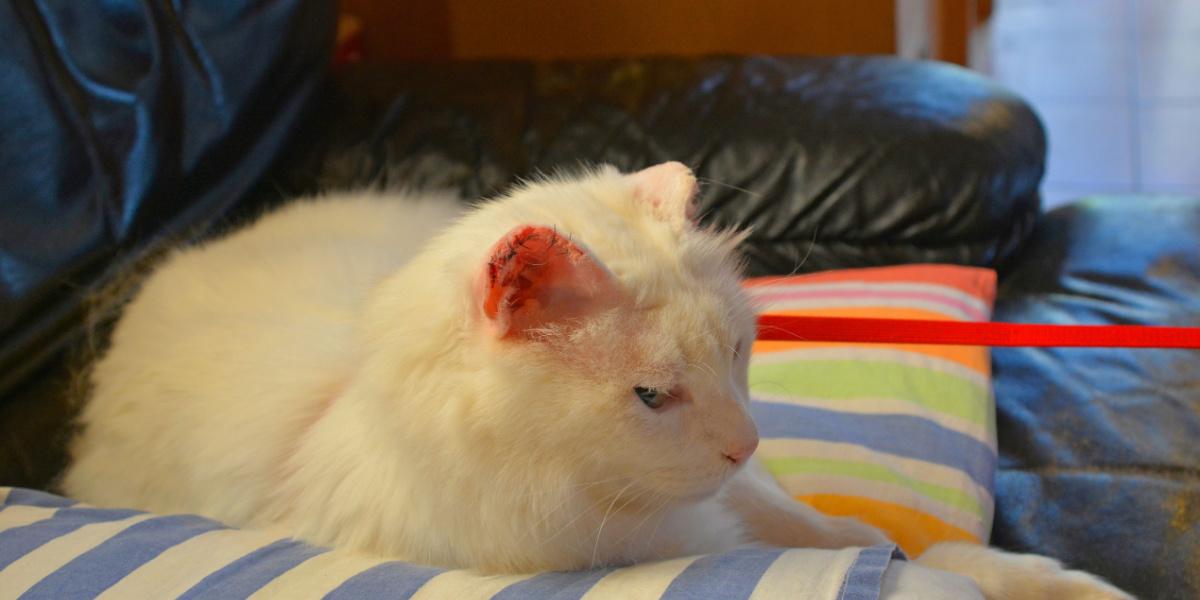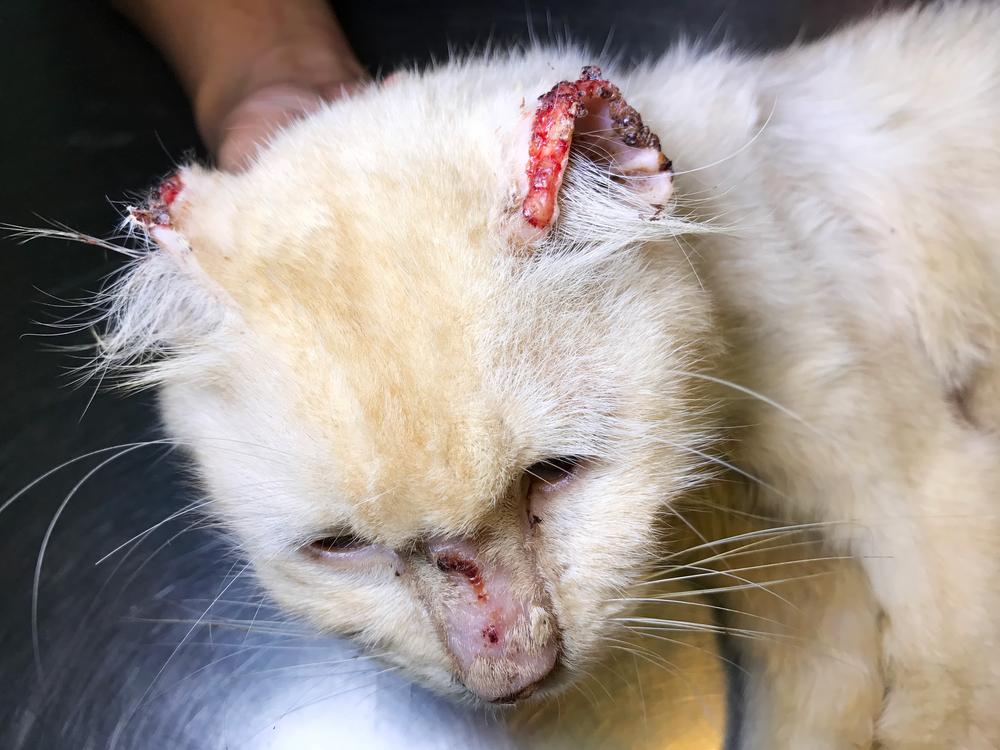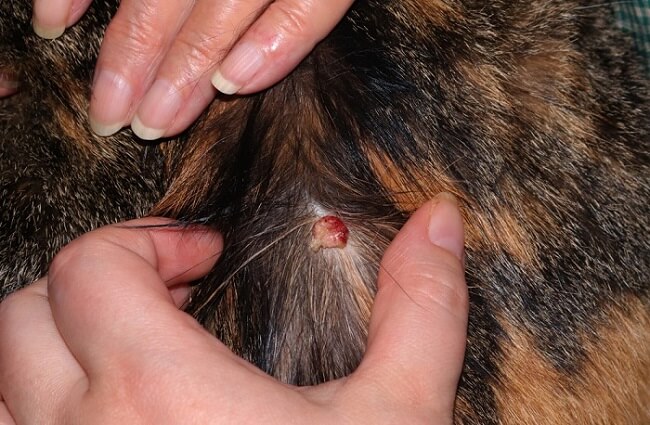
Unfortunately, our feline friends can be affected by many of the same cancers as us. Skin cancer is one of the most common cancers in cats, so it’s really important to know the signs to watch out for.
Early detection can often dramatically affect the outcome for your cat, so it is important to seek veterinary advice quickly if you spot any unusual lumps or changes in your cat’s skin.
What Is Skin Cancer?
Cancer describes a disease caused by a group of abnormal cells dividing uncontrollably, known as a tumor. Some tumors are ‘benign’, meaning they do not damage surrounding tissues and do not spread to other parts of the body.
Benign tumors are not usually harmful unless they are growing quickly or in a delicate place. Others are ‘malignant’, meaning they invade and damage nearby tissues, and/or spread to other parts of the body. Malignant cancers tend to be more serious and harder to treat. Unfortunately, cancer in cats is often malignant.
Skin cancer describes cancer affecting the outer skin (epidermis), or the tissue layers immediately below it. Just as in humans, the exact cause of cancer in cats is unknown. Some cat breeds are more likely to develop cancer.
We know that exposure to some things in the environment can contribute too, such as certain chemicals. In one form of feline skin cancer, exposure to the sun is known to play a large part. There are also some viruses in cats that are known to cause cancer, such as the feline leukemia virus (FeLV) and the feline immunodeficiency virus (FIV).
Common Types of Skin Cancer in Cats

Cancers are grouped and classified according to the cells that they arise in, so there are many different types of skin cancer. Common skin cancers found in cats include:
Squamous Cell Carcinoma (SCC)
This type of cancer is commonly caused by ultraviolet (UV) damage from the sun (sunburn). It is more common in white cats, hairless cats and those with pale skin.
| Common Symptoms | Typically a crusted or ulcerated non-healing sore on the skin. Nose, eyelids, ear tips and lips are most common sites. Multiple lesions may be present in some cases. |
| Diagnosis | Tissue biopsy samples typically with surgical removal. X-rays, ultrasound, CT, MRI imaging and labwork to evaluate for metastatic spread of disease internally. |
| Requires Ongoing Medication | In some cases, continued treatment may be necessary.
|
| Vaccine Available | No |
| Treatment Options | Surgical removal. Follow up radiation therapy and/or chemotherapy may be needed. |
| Home Remedies | None |
It can occur anywhere on the skin but is more likely to affect areas with the least fur, because- like a t-shirt on a hot summer’s day- fur offers a degree of protection from the sun. Squamous cell carcinoma is therefore commonly found on the tips of the ears, eyelids, and nose.
It tends to develop slowly and is more common in cats over the age of 5 years. It can cause very aggressive damage in the area it appears and may occur in more than one site (e.g. both ears). Thankfully, however, it rarely spreads unless it is left untreated.
Mast Cell Tumors (MCTs)
These arise in the mast cells, which are part of the immune system. They can occur anywhere, but are most commonly found around the head and neck.
| Other Names | MCT |
| Common Symptoms | Mast cell tumors of the skin (cutaneous): lumps, swellings, or ulcerative lesions of the skin. Classically, a small raised pink nodule, but many variations exist. In 20% of cats, multiple tumors may be present. Mast cell tumors inside the body (visceral): lethargy, weakness, poor appetite, weight loss. |
| Diagnosis | Skin lesions can be surgically removed for biopsy for confirmed identification. Signs of visceral mast cell disease can mimic many other diseases, often requiring full labwork, x-rays, and ultrasound to rule out other causes. If tumor tissue is found, needle samples for cytology or biopsy may confirm diagnosis. Otherwise, surgical removal of a tumor for biopsy. |
| Requires Ongoing Medication | After surgical removal of mast cell tumors on the skin, further therapy may not be needed, but depends on the severity of the tumor. Internal mast cell tumors often require continued medical therapy. |
| Vaccine Available | No |
| Treatment Options | Antihistamines are important for curbing degranulation of mast cell granules that can lead to swelling of a tumor and a resulting allergic-type response from histamine release. Skin tumors are often small in cats and can be removed, but good margins may depend on location. Further care of a skin tumor depends on the grade (severity) of the tumor type. Internal tumors may be removed depending on the location, but often require additional therapy like chemotherapy or radiation. |
| Home Remedies | None |
Two forms of skin MCTs are found in cats. One is found in older cats and can be anywhere on the spectrum from fairly benign to very malignant. Another form is found in young cats, most commonly Siamese cats. This form tends to go away on its own over time.
Fibrosarcoma
Skin fibrosarcomas originate from fibroblasts, which are the cells that produce the fibrous tissue in the lower layers of the skin. Some are very aggressive and spread, while others are less serious. Injection site sarcomas are commonly fibrosarcomas.
| Common Symptoms | Solid, firm, or raised areas/bumps on the skin that may swell, become reddened, or bleed. Lesions may be single or multiple. |
| Diagnosis | Needle aspirate samples of cells for examination under a microscope (cytology), Tissue biopsy samples of lesions, x-ray, ultrasound, CT, MRI to evaluate for internal tumor spread. |
| Requires Ongoing Medication | In some cases, continued treatment may be necessary.
|
| Vaccine Available | No |
| Treatment Options | Surgical removal of single lesions, chemotherapy, radiation therapy.
|
| Home Remedies | None
|
These are tumors that can appear in the location where a cat has previously had an injection. While these can be very aggressive tumors, thankfully they are relatively rare.
Basal Cell Tumors
These arise from the bottom layer of skin cells, which is the defense layer and plays a role in inflammation. Although they can occasionally be malignant, basal cell tumors are normally benign.
| Common Symptoms | Often appears as a single solid, hairless raised mass on the skin. Mos often on the head neck or shoulders. Masses may have any range of pigmentation/coloration, cystic component, or ulceration. |
| Diagnosis | Needle aspirate samples of cells for examination under a microscope (cytology), tissue biopsy samples of lesions. Metastatic spread internally is uncommon but may be evaluated with x-ray, ultrasound, CT, or MRI. |
| Requires Ongoing Medication | No
|
| Vaccine Available | No |
| Treatment Options | Surgical removal |
| Home Remedies | None |
They only tend to cause a problem if they grow large, or are in an area where the cat licks or scratches at them, since this can lead to bleeding and infection.
Symptoms of Skin Cancer

Lumps on the skin are the primary symptom of skin cancer. Carefully inspecting your cat’s skin coat during regular petting sessions is the best way to identify skin cancer.
While spending some time with your feline friend, try to stroke all areas of their body (if they allow!) daily. This allows you to quickly pick up on any changes to their fur or skin. The majority of the time, a lump on your cat’s fur will be something harmless. However, it is always safest to get it checked out as soon as possible.
Skin cancer in cats can present in many different ways. Whilst the most common symptom is usually a lump or bump under your cat’s skin, non-healing wounds and scabs can also be a sign of cancer, especially of squamous cell tumors.
Other symptoms of feline skin cancers include:
- Lumps or bumps in or under your cat’s skin
- Crusty or scabby areas of skin
- Red, angry areas of skin
- A wound or lesions that will not heal
- Ulcers
- An area of hair loss
- Changes in skin color
As cancer progresses, symptoms may progress to a lack of appetite, weight loss, and excessive thirst.
Skin Cancer in Cats Diagnosis
If your veterinarian suspects skin cancer, they will want to take a sample of the area, so that it can be examined under a microscope. This can be done by collecting some cells with a needle and syringe, called a fine needle aspiration (FNA)/needle biopsy.
Sometimes, an FNA doesn’t provide enough information and your vet may recommend sedating or anesthetizing your cat to cut more of the tumour away.
These samples are then sent to a lab for analysis (histology) Your vet may also want to take samples from your cat’s lymph nodes and take some x-rays (or use an ultrasound), to see if the cancer has spread. Blood work is also useful to determine if there is any damage to your cat’s insides and to help choose the best treatment plan.
Skin Cancer in Cats: Treatment

Fortunately, skin cancer in cats is often treatable, especially if they are caught early. Your cat’s prognosis and treatment will depend on the type of skin cancer and advancement at the time of diagnosis.
A diagnosis of cancer is scary and it is likely to take you some time to come to terms with the diagnosis. Thankfully, skin tumors in cats can often be treated successfully, especially if they are caught early- although some skin cancers are harder to treat than others, and some will unfortunately come back.
Treatment for skin cancer in cats will depend on the type of skin cancer your cat has, how advanced the cancer is when it is diagnosed, and the underlying health of the cat.
Surgical removal is often the first-line treatment, if the cancer is in an area where it can be removed.
With squamous cell carcinoma affecting the ears, treatment involves surgery to remove part, or all, of the pinna (the ear ‘flap’). While this sounds alarming, the surgery can cure your cat. It does not affect the cat’s hearing and they can go on to lead a normal life.
Chemotherapy or radiation therapy may be needed as well; or may be offered if the cancer is in an area that cannot be operated on. Cryosurgery (cryotherapy), which freezes cancer cells to kill them, may also be an option if the tumor cannot be removed by surgery.
If the cancer is too advanced to be treated, or your cat has an underlying medical condition that limits treatment options, then your veterinarian may offer ‘palliative’ treatment as an option. This means treatment to keep your cat comfortable until it is time to say good-bye.
Preventing Skin Cancer in Cats
Whilst cancer can have many different causes, some cancers are partly preventable. For example, reducing sun exposure by keeping your cat indoors during peak sun (normally around 10am-3pm) and using sunscreen designed for cats can decrease the risk of squamous cell carcinoma. Ensuring your cat is fully vaccinated against FELV may help, too.
However, it is important that if your cat is diagnosed with cancer, you don’t blame yourself. As pet owners, it is easy to react with “have I done something wrong?”. Please be re-assured that it is no-one’s fault, and the causes of cancer are complex and poorly understood.
Conclusion
Naturally, the thought of cancer in your feline friend is daunting and scary. Luckily however, most skin cancers in cats are treatable if caught early enough. This is why it is so important to check your cat as often as possible for any lumps, bumps, or changes in their skin. If you aren’t sure, always seek advice from your veterinarian.







